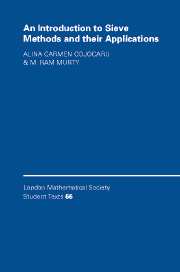Book contents
Preface
Published online by Cambridge University Press: 23 November 2009
Summary
It is now nearly 100 years since the birth of modern sieve theory. The theory has had a remarkable development and has emerged as a powerful tool, not only in number theory, but in other branches of mathematics, as well. Until 20 years ago, three sieve methods, namely Brun's sieve, Selberg's sieve and the large sieve of Linnik, could be distinguished as the major pillars of the theory. But after the fundamental work of Deshouillers and Iwaniec in the 1980's, the theory has been linked to the theory of automorphic forms and the fusion is making significant advances in the field.
This monograph is the outgrowth of seminars and graduate courses given by us during the period 1995–2004 at McGill and Queen's Universities in Canada, and Princeton University in the US. Its singular purpose is to acquaint graduate students to the difficult, but extremely beautiful area, and enable them to apply these methods in their research. Hence we do not develop the detailed theory of each sieve method. Rather, we choose the most expedient route to introduce it and quickly indicate various applications. The reader may find in the literature more detailed and encyclopedic accounts of the theory (many of these are listed in the references). Our purpose here is didactic and we hope that many will find the treatment elegant and enjoyable.
Information
- Type
- Chapter
- Information
- An Introduction to Sieve Methods and Their Applications , pp. xi - xiiPublisher: Cambridge University PressPrint publication year: 2005
